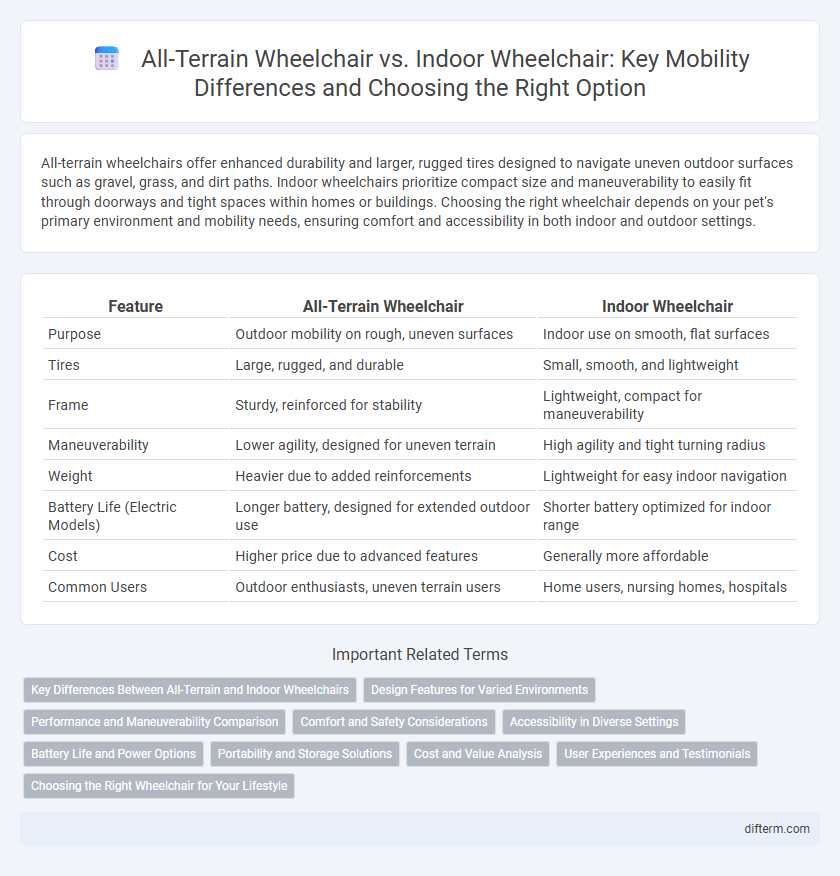All-terrain wheelchairs offer enhanced durability and larger, rugged tires designed to navigate uneven outdoor surfaces such as gravel, grass, and dirt paths. Indoor wheelchairs prioritize compact size and maneuverability to easily fit through doorways and tight spaces within homes or buildings. Choosing the right wheelchair depends on your pet's primary environment and mobility needs, ensuring comfort and accessibility in both indoor and outdoor settings.
Table of Comparison
| Feature | All-Terrain Wheelchair | Indoor Wheelchair |
|---|---|---|
| Purpose | Outdoor mobility on rough, uneven surfaces | Indoor use on smooth, flat surfaces |
| Tires | Large, rugged, and durable | Small, smooth, and lightweight |
| Frame | Sturdy, reinforced for stability | Lightweight, compact for maneuverability |
| Maneuverability | Lower agility, designed for uneven terrain | High agility and tight turning radius |
| Weight | Heavier due to added reinforcements | Lightweight for easy indoor navigation |
| Battery Life (Electric Models) | Longer battery, designed for extended outdoor use | Shorter battery optimized for indoor range |
| Cost | Higher price due to advanced features | Generally more affordable |
| Common Users | Outdoor enthusiasts, uneven terrain users | Home users, nursing homes, hospitals |
Key Differences Between All-Terrain and Indoor Wheelchairs
All-terrain wheelchairs feature durable, large tires, enhanced suspension systems, and robust frames designed for rugged outdoor environments, enabling users to navigate uneven terrain, gravel, and grass with stability. Indoor wheelchairs prioritize compactness, maneuverability, and lightweight construction, making them ideal for tight spaces, smooth floors, and quick turns within home or office settings. These key differences impact user mobility by aligning wheelchair design and functionality with specific environmental needs, offering greater versatility or convenience accordingly.
Design Features for Varied Environments
All-terrain wheelchairs feature rugged tires, reinforced frames, and enhanced suspension systems designed to navigate uneven outdoor terrains such as gravel, grass, and dirt paths. Indoor wheelchairs prioritize compactness, lightweight construction, and maneuverability with smaller wheels and slim profiles for tight spaces and smooth surfaces. The distinct design features optimize functionality and user comfort suited specifically for varied environmental demands.
Performance and Maneuverability Comparison
All-terrain wheelchairs feature rugged tires and enhanced suspension systems designed to navigate rough terrains, providing superior stability and traction on uneven surfaces compared to indoor wheelchairs. Indoor wheelchairs prioritize compact design and lightweight frames to maximize maneuverability in tight spaces like homes and offices, often featuring smaller wheels and tighter turning radii. Performance differences center around terrain adaptability and ease of movement indoors, with all-terrain models excelling outside and indoor wheelchairs optimized for confined environments.
Comfort and Safety Considerations
All-terrain wheelchairs prioritize enhanced comfort and safety features such as rugged suspension systems, high-traction tires, and reinforced frames to navigate uneven outdoor terrains securely. Indoor wheelchairs emphasize lightweight designs and tight maneuverability with cushioned seating and stability controls to ensure user comfort and safety in confined spaces. Selecting between these models depends on the user's primary mobility environment and specific ergonomic requirements.
Accessibility in Diverse Settings
All-terrain wheelchairs are designed with rugged tires and advanced suspension systems to navigate uneven outdoor terrains, providing greater accessibility in parks, trails, and rough environments. Indoor wheelchairs prioritize compactness and maneuverability, allowing users to easily access narrow hallways, doorways, and confined spaces within homes or public buildings. Selecting the appropriate wheelchair type enhances mobility independence by aligning with specific accessibility needs in diverse settings.
Battery Life and Power Options
All-terrain wheelchairs typically feature high-capacity lithium-ion batteries designed to support extended outdoor use and rough terrains, often offering battery lives ranging from 10 to 20 miles per charge. Indoor wheelchairs prioritize compact power systems with moderate battery capacity, usually providing 8 to 12 miles per charge, optimizing maneuverability in confined spaces. Power options for all-terrain models include robust motors and advanced suspension systems to handle uneven surfaces, while indoor wheelchairs focus on energy-efficient motors suitable for smooth, flat flooring.
Portability and Storage Solutions
All-terrain wheelchairs feature rugged frames and larger tires designed for outdoor mobility, but they tend to be bulkier and heavier, making portability and storage more challenging. Indoor wheelchairs prioritize lightweight materials and compact designs, allowing for easier folding and stowing in tight spaces like closets or car trunks. Choosing between these wheelchairs depends on the user's primary environment and the need for convenient transport and storage solutions.
Cost and Value Analysis
All-terrain wheelchairs typically cost between $1,000 and $3,500 due to reinforced frames and specialized tires designed for rugged environments, offering significant durability and outdoor mobility. Indoor wheelchairs generally range from $300 to $2,000, featuring lightweight materials and compact designs optimized for ease of maneuvering in tight spaces, emphasizing convenience over heavy-duty use. Evaluating cost and value requires balancing the initial investment against specific mobility needs, where all-terrain models provide enhanced versatility and lasting performance, while indoor wheelchairs offer affordability and practicality for everyday home use.
User Experiences and Testimonials
Users of all-terrain wheelchairs frequently highlight enhanced independence and confidence when navigating diverse outdoor environments, noting robust durability and superior traction as key benefits. Indoor wheelchair users often emphasize maneuverability and compact design, which allow for easy navigation in tight spaces and improved comfort during prolonged use. Testimonials reveal that while all-terrain models excel in challenging outdoor terrains, indoor wheelchairs optimize daily living activities, guiding user preference based on lifestyle needs.
Choosing the Right Wheelchair for Your Lifestyle
Selecting the right wheelchair depends on your primary mobility environment and daily activities, with all-terrain wheelchairs designed for rugged outdoor use featuring durable tires and suspension for uneven surfaces. Indoor wheelchairs prioritize maneuverability and compact size to navigate tight spaces and doorways effectively. Evaluating your lifestyle needs like terrain, space constraints, and usage frequency ensures optimal comfort, safety, and mobility.
All-terrain wheelchair vs Indoor wheelchair Infographic

 difterm.com
difterm.com